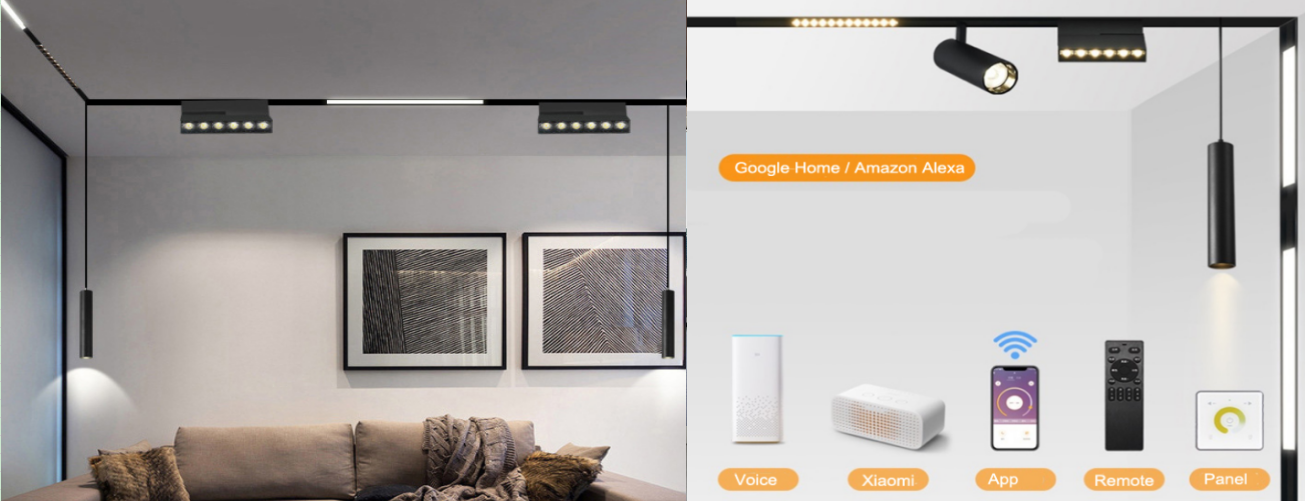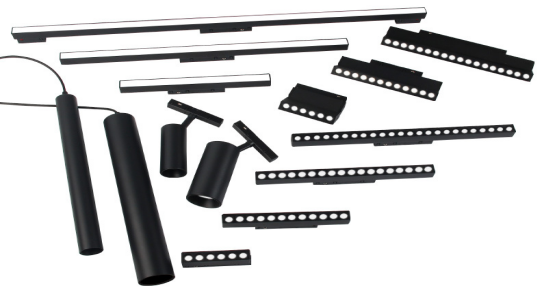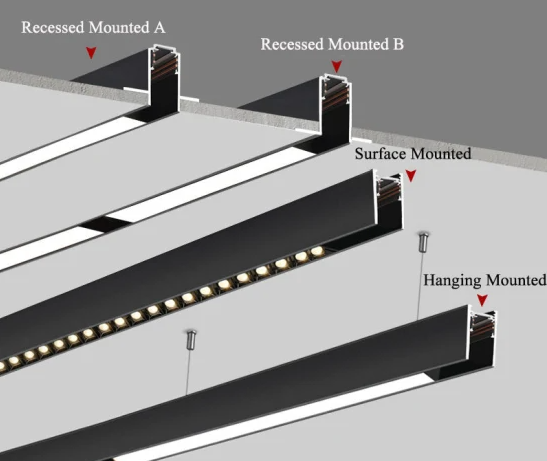
LED magnetic track lights have become increasingly popular in home decoration in recent years, and more and more people are choosing them. For those who are installing magnetic rail lights for the first time in Nigeria or want to learn about magnetic track lights, be sure to understand the following details to avoid pitfalls during the installation process.
What is the magnetic track lights? and how many light types included?
The installation and removal of lamps are achieved through magnetic attraction. Its advantages are easy installation and removal, and it is particularly suitable for scenes where lamps need to be frequently replaced.
The magnetic track light types include linear profile light, grille spotlights, fold spotlights, track spotlights, and pendant lights, etc.

What are the installation methods of magnetic track lights?
There are mostly including 4 different installation ways for 3 types of magnetic track rails.
- Recessed Installation. Pre-embed the track during the ceiling renovation process and secure it to the keel and drywall to enhance stability and prevent cracking.
- Trimless Plaster Installation. After securing the track in the pre-reserved slots, apply the plaster finish. Careful construction techniques are essential to avoid problems such as screw holes and dust shedding.
- Surface-mounted Installation. For applications without pre-reserved slots, this method allows for track fixation via a ceiling-mounted installation. However, the raised track strips may affect the aesthetics.
- Suspension hanging Installation. The height of the fixture can be adjusted using wires. This is commonly used in dining rooms or above desks, allowing for flexible positioning.
You can download her for the magnetic track installation guide.
When cleaning magnetic track lights, will a slightly damp towel cause leakage
Magnetic track lights will not cause electric shock. They use a 48V voltage, which is equivalent to human body voltage. There’s no sense of contact, and there’s no risk of contact points. Even if they’re installed while powered, there won’t be any problems.
What voltage do magnetic track lights require?
48V is required. Since magnetic track lights can be replaced and moved, they require a high level of safety.
Why not choose a voltage lower than 48V? Wouldn't that be safer?
Low voltage can easily cause voltage drop. Voltage drop means the voltage is too low and the current is insufficient, resulting in insufficient power supply to subsequent lights and reduced brightness. The 48V voltage required by magnetic track lights allows for a single 20-meter series connection without voltage drop, ensuring both safety and practicality.
What is the installation steps for magnetic track lights?
① Reserve lighting wiring during plumbing and electrical installation. ② Before carpentry work begins, select the track for your track lights and determine the desired track length. ③ Consult the manufacturer for specific dimensions. Once the dimensions are confirmed, provide them to the carpenter. ④ Have the carpenter build the ceiling and wooden box according to the manufacturer’s dimensions. ⑤ Track lights also require a transformer. Before carpentry work begins, consider how to route the transformer if it’s hidden.
⑥ After carpentry work is completed, the track needs to be installed before the painter can begin puttying and painting the walls.
⑦ Masking tape is required before the painter begins.
You can download here about magnetic track installation guide.
If the walls have already been painted, can magnetic lights still be installed?
Magnetic track lights come in pre-buried, ceiling-mounted, and surface-mount styles. If the walls are already painted, you can consider installing surface-mounted magnetic track.
What length available for magnetic track rails?
Originally, the lengths for magnetic track rail included 1m/pcs, 2m/pcs, and 3m/pcs. But they are available to be cut off for any length, in this case, when your design for a magnetic track light system is 5meter, 10meter or 20meter, then you can use different length to be, with connector.
How many lighting sets can be connected to one transformer (external led driver)?
It’s recommended to connect a maximum of two lighting sets ( two circuits )to avoid compromising safety and stability.
Where should the transformer be placed?
Recommended placement is near the central air conditioning access port, electrical box, light strip recess, or inside a cabinet. Then it is easier to do repair or replacement for led transformer once there is any broken or burnt for a external driver.
What is the distance from the wall for installing the magnetic track?
General Range: In most scenarios, magnetic track lights should be kept 50-80 cm from the wall to avoid overexposure and uneven light distribution.
- However, adjustments can be made in the following situations:
If the space is small or if accent lighting is required (such as a TV wall), the distance can be shortened to 40-50 cm. - For floating ceilings or large flat ceilings, a distance of 20 cm from the wall is recommended (depending on the height of the ceiling fixtures).
- If side fixtures are used, additional thickness will be required (e.g., 30 cm or more). In this case, the track distance from the wall should be adjusted to 60-70 cm.
What thickness of drywall is suitable for magnetic track lights?
Conventional track lights are suitable for 9-10 mm drywall. There’s basically no thickness restriction these days, as multifunctional track lights are height-adjustable.
How do I choose the color temperature for magnetic track lights?
The color temperature is generally 3000K-4000K. Higher numbers indicate whiter light, while lower numbers indicate yellower light. It all comes down to personal preference. Generally, we recommend 3500-4000K for living rooms and 3000-3500K for bedrooms.
How do I choose the beam angle for magnetic track lights?
A smaller beam angle provides more focused light, while a larger one provides a wider illumination range. If you prefer a more versatile 24″ beam angle, go with it.
Spotlights beam angle is 24°/36° optional for accent lighting.
Linear profile lights is 120° for basic lighting.
How do I choose the color rendering index (CRI) for magnetic track lights?
Lorem ipsum dolor sit amet, consectetur adipiscing elit. Ut elit tellus, luctus nec ullamcorper mattis, pulvinar dapibus leo.
How to choose the required wattage for magnetic track lights?
The total wattage of general household lighting can be calculated based on 3W/㎡ for the living room, 2W/㎡ for the bedroom, and 5W/㎡ for the kitchen, and then allocated to different light sources. For example, the total brightness of a 20㎡ living room can be controlled at around 60W; for a 10㎡ bedroom, a total of 20w is enough.
You can contact us in Nigeria if you need more information, or have any other questions or requirements for this magnetic track lighting system.
 Eurolight
Eurolight

